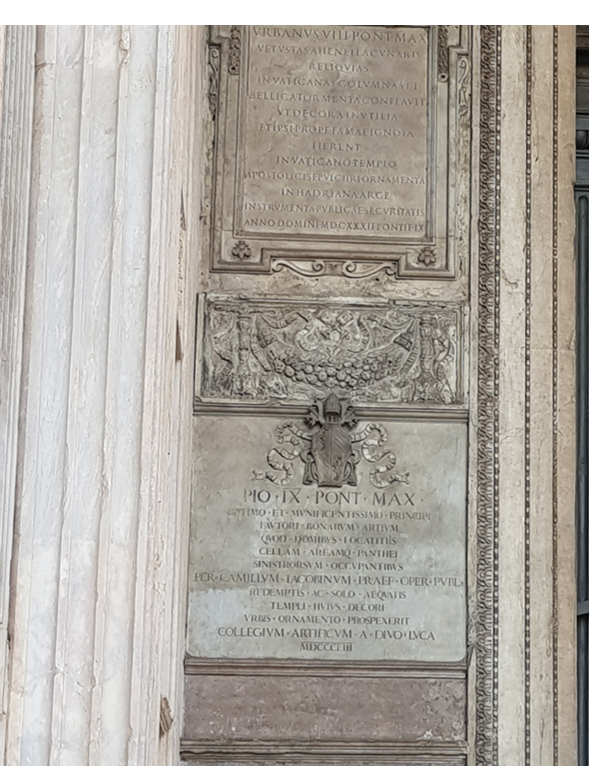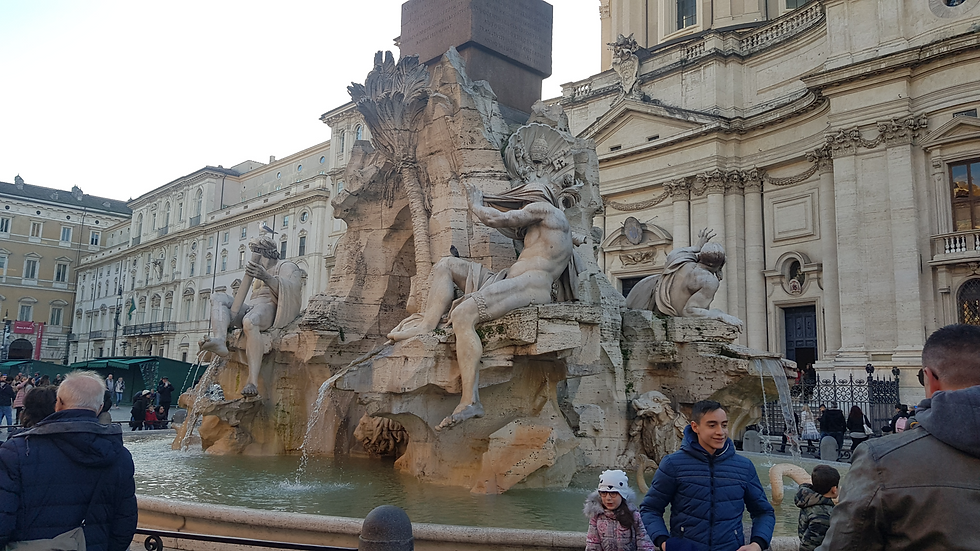Veni Vidi Vici - Part IV - Piazzas, Pinocchio, Pantheon
- beehelm0410
- Jul 27, 2022
- 4 min read
Fontana della piazza Colonna
The fountain in the piazza was commissioned by Pope Gregory XIII in 1577, from Giacomo Della Porta who was assisted by Rocco De Rossi. It was restored in 1830, and had two sets of dolphins side by side, with tails entwined, sculpted by Achille Stocchi, set at either end of the long basin. The central sculpture substituted with a smaller sculpture and spray

Pinocchio is synonymous with Italy from 1881. The creator of Pinocchio (Giornale dei bambini di Firenze) was Carlo Lorenzini, most commonly known as Carlo Collodi from Collodi, a small Tuscan town.
Pinocchio souvenirs are all over Rome and there are Pinocchio toy stores and there is “THE” Pinocchio toy store which we discovered later on this Saturday, 14 December 2019 at Bartolucci, a store which has been in existence since 1506 (it is situated near the Pantheon)





T
The Column of Marcus Aurelia in Piazza Colonna
The marble column of the Roman Emperor, Marcus Aurelia, is 30 metres high. It was erected after Marcus Aurelia’s death in the 2nd century AD. During its restoration in the 16th century, Pope Sixtus V ordered the statue of Saint Paul to be placed on top of the column.


Palazzo Chigi, the official residence of the Italian Prime Minister, built in 1562, in Piazza Colonna



The oldest magic shop in Rome (it was started in the 1970’s) which was on Johan’s list of places to see and visit in Rome. It is located close to Piazza Navona and we literally right into it without specifically looking for it

Matteo was working in Eclectica on the afternoon of our visit. He is a magician and Johan showed him a few of his tricks and Matteo gave Johan some invaluable advice and assistance.

The Fontana del Pantheon / Fountain of the Pantheon) was commissioned by Pope Gregory XIII. It is located in the Piazza della Rotanda in Rome right in front of the Pantheon. Giacoma della Porta designed it in 1571 and it was sculpted out of marble by Leonardo Sormani.
In 1711, Pope Clement XI requested that the fountain be modified. Filippo Barigioni designed a new layout, which included a different basin, made of stone, and the Macuteo obelisk which was created during the period of Ramses II, set in the centre on a plinth with four dolphins decorating the base.
The original marble figures were removed in 1886 and replaced with copies by Luigi Amici. The originals may be seen in the Museum of Rome.

The Pantheon

Below is the dome in the Pantheon – it is never closed and is open whether the sun is shining, rain is falling or it is snowing!
Silence is requested when in the Pantheon and this is strictly “policed” by a strong security presence. The Pantheon is free to enter so was definitely one of our list of free attractions to visit visiting Rome on our threadbare string budget.






One of the many presepi (nativity scenes) we were to see during our Roman adventures


Johan in the Pantheon. Where it is possible to sit and contemplate your surroundings in Rome, please do so. The beauty of our length of time in Rome meant we could indulge in quiet contemplation, appreciation and awe of our beautiful surroundings, for example as we did in the Pantheon.


Always look up


Always something to see - up, down, left, right and all around you



How to stop a tourist in Italy? They order cappuccinos post noon and/or post dinner - we commit the ultimate faux pas doing this on our Saturday wanderings and explorations

Window shopping - another free activity.
The Gladiator Store, Piazza Navona




Piazza Navona
The Piazza Navona It is built on the site of the Stadium of Domitian, built in the 1st century AD, and follows the form of the open space of the stadium (oval shape). The ancient Romans went there to watch the agones, therefore, it was known as "Circus Agonalis". It is said that over time the name changed to in avone to navone and eventually to navona. In the centre of the Piazza Navona stands the famous fountain, Fontana dei Quattro Fiumi or Fountain of the Four Rivers (1651) by Gian Lorenzo Bernini, topped by the Obelisk of Domitian, brought in pieces from the Circus of Maxentius.
At the southern end of the Piazza Navona is the Fontana del Moro with a basin and four Tritons sculpted by Giacomo della Porta (1575) to which, in 1673, Bernini added a statue of a Moor, wrestling with a dolphin. At the northern end you will find the Fountain of Neptune (1574) also created by Giacomo della Porta; the statue of Neptune, by Antonio Della Bitta, was added in 1878 to create a balance with La Fontana del Moro.


Seagulls are everywhere you look in Rome and they love perching on the top of the heads of all the statues!


Sant’ Agnese in Agone / Sant’ Agnese is situated in the Piazza Navona. It is a 17th Century Baroque Church














The Fountain of the Moor Fountain at the southern end of the Piazza Navona



A treat of gelato from Frigidarium was a must on our first full day in Rome!
There was a queue – good sign that the gelato is not just good, its excellent and it sure was! The topping on the ice cream was included in the price of €3 per gelato; a very average price for gelato in Rome …. Don’t do the Euro/Rand conversion as its too painful ….. But when in Rome …..!!
It was a 4 minute walk from the Piazza Navona situated at Via del Governo Vecchio, 112, 00186 Roma

As we figured out how to head home we encountered the tail end of a Carabinieri horse parade … we did not take a photo of the vehicle which followed the horses cleaning up all the horse dung!!


The presepe outside the Figlie della Chiesa, a convent located a short walking distance from Domus Getsemani – we walked past the convent most days (it was being constructed by the nuns the day we arrived)






Comments